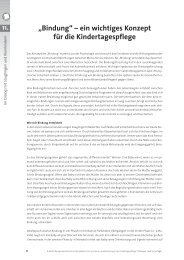download - Deutsches Jugendinstitut e.V.
download - Deutsches Jugendinstitut e.V.
download - Deutsches Jugendinstitut e.V.
You also want an ePaper? Increase the reach of your titles
YUMPU automatically turns print PDFs into web optimized ePapers that Google loves.
conventional aspirations in illegal ways. Others (a significant minority) give up, and retreat<br />
into alcohol and drug dependency. Others (though very few!) challenge the system through<br />
political action. This theoretical position resonated loud and clear in my study of the<br />
Milltown Boys. It point to the need for positive structures of legitimate opportunity,<br />
wherever possible, to be supported through a partnership of private and public policy.<br />
Conclusion<br />
There is no magic wand for social inclusion and cohesion at the local level, any more than<br />
there is any natural blueprint for a youth policy framework at a European level. But there is<br />
an integral link between the two: local initiatives cannot ignore the wider policy framework<br />
any more than the European agenda can deny its need for effective local delivery.<br />
There are, however, some fundamental pre-requisites if we are to produce appropriate<br />
measures in both policy and practice. First, it is imperative to understand the specifics of<br />
youth transitions and their implications. These operate in different and complex ways in<br />
terms of both their influences and outcomes. We need to grasp the nature and experiences of<br />
the challenges faced by different young people, and the real and anticipated consequences of<br />
those processes, at personal and cultural levels as well as social and economic levels. Criteria<br />
that is often hidden from outsiders can be critical in informing choices and motivating<br />
engagement.<br />
The related second point is that grand strategies, based on ‘objective’ top-down<br />
aspirations and analysis (such as to establish a ‘knowledge-based economy’) must be tuned<br />
and attuned to more ‘subjective’ bottom-up expectations and perspectives. In short, the<br />
structural must meet the cultural.<br />
If we want a Europe characterised by inclusion and cohesion, it will be essential to<br />
construct routes of access and opportunity for young people who cannot secure them with<br />
the support of their families. And we will have to make sure that we reach the right young<br />
people in the right places and make them a sensible and credible offer, otherwise we will<br />
inadvertantly be contributing to the social divide by enlarging opportunities only for them to<br />
be taken disproportionately by young people who are already largely on the right side of the<br />
tracks, leaving those on the other side still left a long way behind.<br />
Literature<br />
Cloward, L. and Ohlin, R. (1960), Delinquency and Opportunity, London: Routledge and<br />
Kegan Paul<br />
Lauritzen, P. and Guidikova, I. (2002), 'European Youth Development and Policy: The Role<br />
of NGOs and Public Authority in the Making of the European Citizen', in R. Lerner, F.<br />
Jacobs and D. Wertlieb (eds), Handbook of Applied Developmental Science 3, London:<br />
Sage pp 363-382<br />
Marris, P. and Rein, M. (1972), Dilemmas of Social Reform, Harmondsworth: Penguin<br />
Williamson, H. and Weatherspoon, K. (1985), Strategies for Intervention: an approach to<br />
youth and community work in an area of social deprivation, University College Cardiff:<br />
Social Research Unit<br />
Williamson, H. (2002), Supporting young people in Europe: principles, policy and practice,<br />
Strasbourg: Council of Europe<br />
Williamson, H. (2004), The Milltown Boys Revisited, Oxford: Berg<br />
104

















